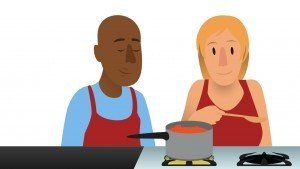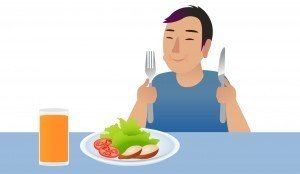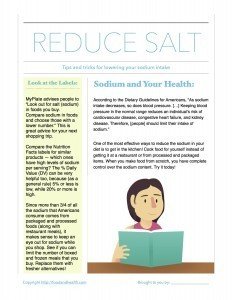5 Top Tips to Reduce Sodium Intake
 According to the Dietary Guidelines for Americans, "A strong body of evidence in adults documents that as sodium intake decreases, so does blood pressure. […] Keeping blood pressure in the normal range reduces an individual’s risk of cardiovascular disease, congestive heart failure, and kidney disease. Therefore, [people] should limit their intake of sodium."But where to start?Reducing your sodium intake can be a bit tricky, so start with these 5 top tips to reduce your sodium intake...Sodium Reduction Tip #1: Compare LabelsMyPlate advises people to "Look out for salt (sodium) in foods you buy. Compare sodium in foods and choose those with a lower number." This is great advice for your next shopping trip. Compare the Nutrition Facts labels for similar products -- which ones have high levels of sodium per serving? The % Daily Value (DV) can be very helpful here, because as a general rule 5% or less is low, while 20% or more is high.
According to the Dietary Guidelines for Americans, "A strong body of evidence in adults documents that as sodium intake decreases, so does blood pressure. […] Keeping blood pressure in the normal range reduces an individual’s risk of cardiovascular disease, congestive heart failure, and kidney disease. Therefore, [people] should limit their intake of sodium."But where to start?Reducing your sodium intake can be a bit tricky, so start with these 5 top tips to reduce your sodium intake...Sodium Reduction Tip #1: Compare LabelsMyPlate advises people to "Look out for salt (sodium) in foods you buy. Compare sodium in foods and choose those with a lower number." This is great advice for your next shopping trip. Compare the Nutrition Facts labels for similar products -- which ones have high levels of sodium per serving? The % Daily Value (DV) can be very helpful here, because as a general rule 5% or less is low, while 20% or more is high. Sodium Reduction Tip #2: Limit Boxed and Frozen FoodsThe Centers for Disease Control and Prevention (CDC) have revealed that "More than 75% of the sodium Americans eat comes from restaurant, prepackaged, and processed foods." When you're shopping, see if you can limit the number of boxed and frozen meals that you buy. Replace them with fresher alternatives! For example, you can replace boxed and flavored rice mix with brown rice that you cook yourself. Instead of picking up frozen pizza, get some low-sodium dough, sauce, and cheese and then whip up your own pizza in the time that it takes to preheat the oven. The more packaged and processed foods you replace with fresh and sodium-free alternatives, the better.Sodium Reduction Tip #3: Rinse Canned FoodsDid you know that rinsing canned foods can actually reduce the amount of sodium that they contain? It's true! The National Heart, Lung, and Blood Institute advises people to "Rinse canned foods to reduce the sodium," and the study Effect of water rinsing on sodium content of selected foods revealed "A 3-minute rinse of tuna and cottage cheese resulted in sodium reductions of 80% and 63%." You can also rinse canned beans or canned pasta (though you'll probably want to cook the pasta in a low-sodium sauce after rinsing).
Sodium Reduction Tip #2: Limit Boxed and Frozen FoodsThe Centers for Disease Control and Prevention (CDC) have revealed that "More than 75% of the sodium Americans eat comes from restaurant, prepackaged, and processed foods." When you're shopping, see if you can limit the number of boxed and frozen meals that you buy. Replace them with fresher alternatives! For example, you can replace boxed and flavored rice mix with brown rice that you cook yourself. Instead of picking up frozen pizza, get some low-sodium dough, sauce, and cheese and then whip up your own pizza in the time that it takes to preheat the oven. The more packaged and processed foods you replace with fresh and sodium-free alternatives, the better.Sodium Reduction Tip #3: Rinse Canned FoodsDid you know that rinsing canned foods can actually reduce the amount of sodium that they contain? It's true! The National Heart, Lung, and Blood Institute advises people to "Rinse canned foods to reduce the sodium," and the study Effect of water rinsing on sodium content of selected foods revealed "A 3-minute rinse of tuna and cottage cheese resulted in sodium reductions of 80% and 63%." You can also rinse canned beans or canned pasta (though you'll probably want to cook the pasta in a low-sodium sauce after rinsing). Sodium Reduction Tip #4: Cook It YourselfThis is probably the most effective way to reduce your sodium intake. Cook food for yourself instead of getting it at a restaurant or from processed and packaged options. Instead of using bottled dressings, use oil and vinegar from your pantry. Roast and puree some vegetables for a low-sodium alternative to pasta sauce. Make oatmeal instead of pouring a bowl of processed cereal. The possibilities are endless! When you make food from scratch, you have complete control over the sodium content. So have fun in the kitchen, limiting the salt you use and keeping an eye out for high-sodium condiments like mustard, ketchup, and soy sauce. Your blood pressure will thank you.Sodium Reduction Tip #5: Flavor Foods with Herbs and Spices Instead of Salt"Low sodium" doesn't have to mean "low flavor!" Replace salt with fresh or dried herbs for some serious flavor boosts. You can also try a variety of fun spices to add levels of complexity to a dish. Start small and taste frequently in order to get a dish that you're proud of.There are lots of other sodium resources in the Nutrition Education Store! We're here to help you look your very best, right now...
Sodium Reduction Tip #4: Cook It YourselfThis is probably the most effective way to reduce your sodium intake. Cook food for yourself instead of getting it at a restaurant or from processed and packaged options. Instead of using bottled dressings, use oil and vinegar from your pantry. Roast and puree some vegetables for a low-sodium alternative to pasta sauce. Make oatmeal instead of pouring a bowl of processed cereal. The possibilities are endless! When you make food from scratch, you have complete control over the sodium content. So have fun in the kitchen, limiting the salt you use and keeping an eye out for high-sodium condiments like mustard, ketchup, and soy sauce. Your blood pressure will thank you.Sodium Reduction Tip #5: Flavor Foods with Herbs and Spices Instead of Salt"Low sodium" doesn't have to mean "low flavor!" Replace salt with fresh or dried herbs for some serious flavor boosts. You can also try a variety of fun spices to add levels of complexity to a dish. Start small and taste frequently in order to get a dish that you're proud of.There are lots of other sodium resources in the Nutrition Education Store! We're here to help you look your very best, right now...

 And here's a brand-new PDF handout that features the highlights from this post...
And here's a brand-new PDF handout that features the highlights from this post...

